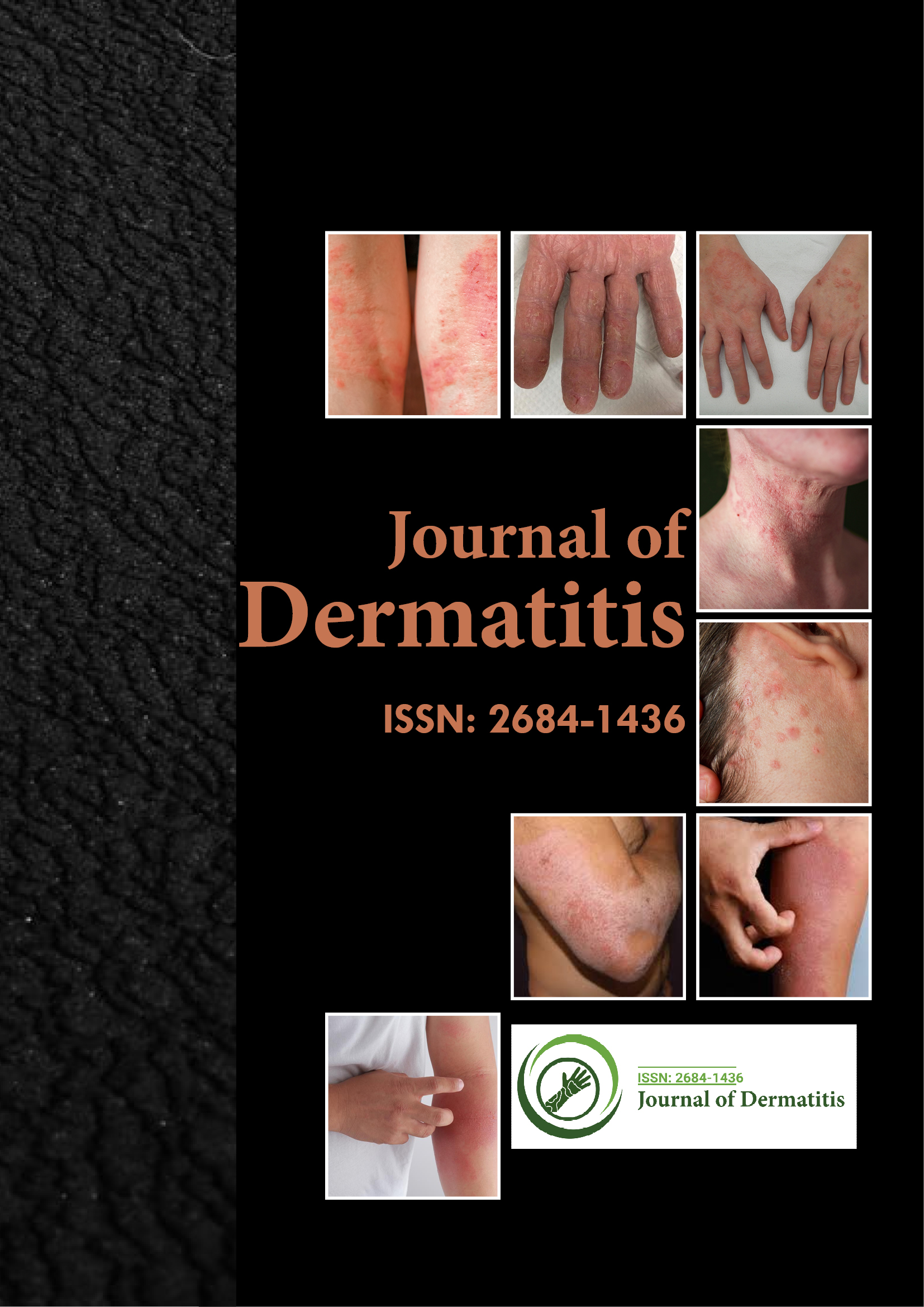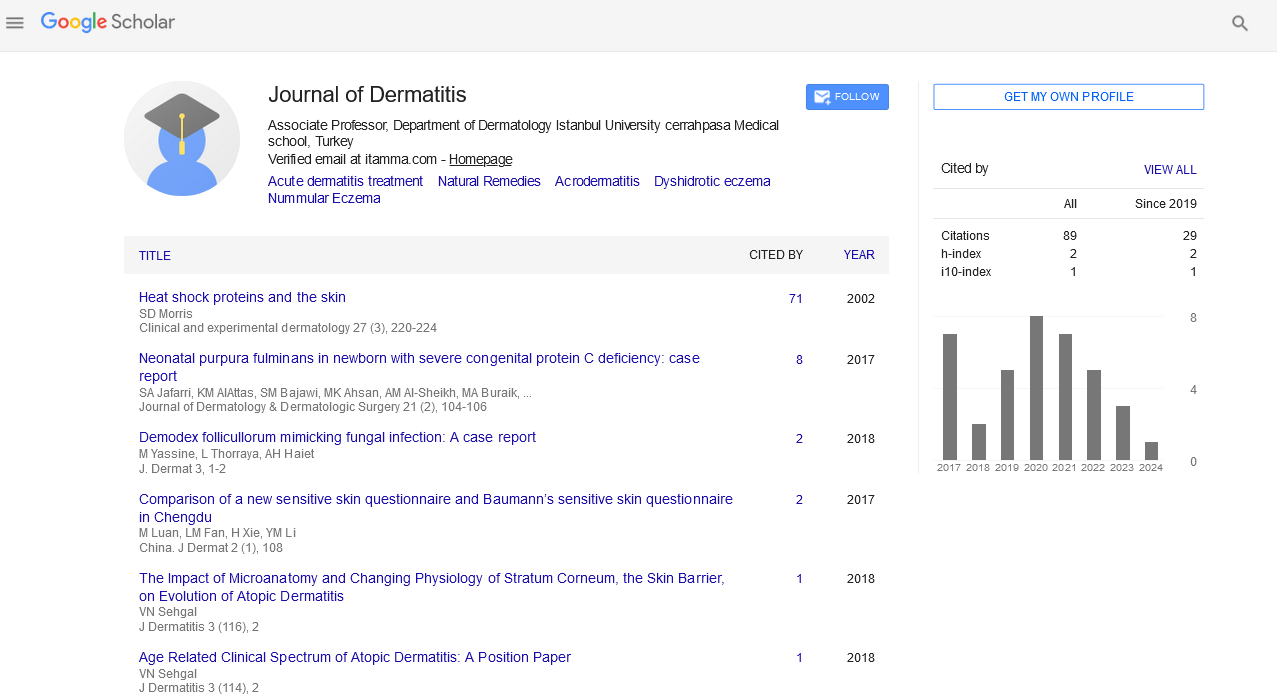Indexed In
- RefSeek
- Hamdard University
- EBSCO A-Z
- Euro Pub
- Google Scholar
Useful Links
Share This Page
Journal Flyer

Open Access Journals
- Agri and Aquaculture
- Biochemistry
- Bioinformatics & Systems Biology
- Business & Management
- Chemistry
- Clinical Sciences
- Engineering
- Food & Nutrition
- General Science
- Genetics & Molecular Biology
- Immunology & Microbiology
- Medical Sciences
- Neuroscience & Psychology
- Nursing & Health Care
- Pharmaceutical Sciences
Commentary - (2025) Volume 10, Issue 2
Understanding the Immunological Basis of Dermatitis
Karen Hristakieva*Received: 19-Jan-2024, Manuscript No. JOD-24-24656; Editor assigned: 23-Jan-2024, Pre QC No. JOD-24-24656 (PQ); Reviewed: 06-Feb-2024, QC No. JOD-24-24656; Revised: 06-Jan-2025, Manuscript No. JOD-24-24656 (R); Published: 13-Jan-2025, DOI: 10.35248/2684-1436.25.10.275
Description
Dermatitis, a broad term encompassing various inflammatory skin conditions, has been a subject of extensive research aimed at unravelling the complex immunological mechanisms underlying its pathogenesis. The intricate process between the immune system and the skin plays a pivotal role in the development, progression, and exacerbation of dermatitis. Understanding the immunological basis of dermatitis is important for advancing therapeutic approaches, improving patient outcomes, and fostering a more comprehensive perspective on skin health.
The skin, the body's largest organ, serves as a vital barrier between the internal environment and the external world. Its primary function is to protect against pathogens, toxins, and environmental stressors. The immune system, comprising a network of cells, tissues, and molecules, plays a central role in maintaining skin homeostasis and responding to potential threats.
In dermatitis, this delicate balance between skin and immune system is disrupted, leading to inflammatory responses and the characteristic symptoms associated with various forms of the condition. Atopic dermatitis, contact dermatitis, and seborrheic dermatitis are among the common dermatologic disorders influenced by immunological factors.
Atopic dermatitis, often referred to as eczema, is a chronic and relapsing inflammatory skin condition characterized by red, itchy, and inflamed skin. The immunological basis of atopic dermatitis involves a complex interplay between genetic predispositions, environmental triggers, and dysregulation of the immune response. Genetic factors, particularly variations in genes associated with skin barrier function and immune regulation, contribute to an individual's susceptibility to atopic dermatitis.
The skin barrier, composed of the outermost layer known as the stratum corneum, plays a important role in atopic dermatitis pathogenesis. Disruptions in the skin barrier allow allergens, irritants, and microbes to penetrate the skin, triggering an immune response. Filaggrin, a protein essential for maintaining skin barrier integrity, is often deficient in individuals with atopic dermatitis, leading to increased permeability and susceptibility to environmental triggers.
The immune response in atopic dermatitis involves a type I hypersensitivity reaction, commonly known as an allergic response. Exposure to allergens, such as dust mites, pet dander, or certain foods, triggers the release of Immunoglobulin E (IgE) antibodies. These antibodies bind to mast cells and basophils, leading to the release of histamine and other inflammatory mediators. The resulting inflammation contributes to the characteristic redness, itching, and skin lesions observed in atopic dermatitis.
Moreover, atopic dermatitis is associated with a Th2-predominant immune response, characterized by an overactivation of T-helper cells of the Th2 subset. Th2 cells release cytokines, such as Interleukin-4 (IL-4) and Interleukin-13 (IL-13), which further amplify the inflammatory cascade. The chronic nature of atopic dermatitis reflects a dysregulated immune response, with a persistent Th2-dominated milieu contributing to prolonged inflammation and recurrent flares.
Contact dermatitis, another common form of dermatitis, involves an immune response triggered by exposure to irritants or allergens. The immunological basis of contact dermatitis includes both innate and adaptive immune responses. Irritant contact dermatitis results from direct damage to the skin caused by exposure to irritants, such as harsh chemicals or detergents. This damage activates the innate immune system, leading to the release of pro-inflammatory cytokines and the recruitment of immune cells to the site of exposure.
Allergic contact dermatitis, on the other hand, is an immunemediated response involving the adaptive immune system. Sensitization, the initial exposure to an allergen, leads to the activation of specific T cells known as CD4+ T cells. Upon subsequent exposure, these memory T cells recognize the allergen and orchestrate an immune response. Cytotoxic T cells and other immune cells infiltrate the skin, releasing inflammatory mediators and causing the characteristic symptoms of allergic contact dermatitis, such as redness, swelling, and itching.
Seborrheic dermatitis, characterized by red, scaly patches and inflammation in areas rich in sebaceous glands, also has immunological components. The role of the yeast Malassezia, a normal inhabitant of the skin, has been implicated in seborrheic dermatitis pathogenesis. Malassezia can trigger an inflammatory response through interactions with the immune system, particularly the activation of complement components and the release of pro-inflammatory cytokines.
The concept of the skin microbiome, the diverse community of microorganisms residing on the skin, adds another layer to the immunological basis of dermatitis. Microbial dysbiosis, an imbalance in the composition of the skin microbiome, has been implicated in the pathogenesis of dermatitis. Perturbations in the microbial communities can influence the immune response, contributing to inflammation and skin barrier dysfunction.
Conclusion
The immunological basis of dermatitis encompasses a complex interplay between genetic predispositions, environmental triggers, and dysregulation of the immune response. From atopic dermatitis to contact dermatitis and seborrheic dermatitis, understanding the immunological mechanisms involved in these conditions provides a foundation for developing targeted and effective therapeutic strategies.
Citation: Hristakieva K (2025) Understanding the Immunological Basis of Dermatitis. J Dermatitis. 10:267.
Copyright: © 2025 Hristakieva K. This is an open access article distributed under the terms of the Creative Commons Attribution License, which permits unrestricted use, distribution, and reproduction in any medium, provided the original author and source are credited.

